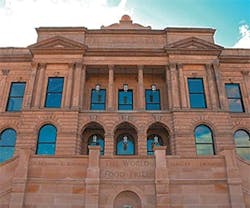Nineteenth-Century Building Earns LEED Platinum
Renovating a historic building into a LEED Platinum facility is almost like converting a Model T into a hybrid.
But the headquarters of the World Food Prize Foundation – formerly the Des Moines Public Library – pulled off that feat.
Designed in the 19th century with the cornerstone laid in 1900, today the facility serves as a landmark in energy efficiency.
Fewer than 10 historic buildings in the U.S. have earned Platinum certification, but a $30 million renovation garnered the World Food Prize Hall of Laureates status in this elite club.
Some of the key features of the project are as follows.
- Ninety high-efficiency, American-made solar panels are installed on the roof. But in keeping with the National Register of Historic Places designation, the array lays flat so the panels don’t stick up and detract from the historic appearance.
- An 8,000-gallon cistern collects stormwater run-off that is used for garden irrigation and toilet flushing.
- Almost all construction materials were procured from within 500 miles and included many recycled or reused materials. For example, sandstone for the facade came from Minneapolis as opposed to the Middle East.
- A geothermal heating and cooling system, which uses 200-foot wells dug under the property, cycles either warm or cold air into the building’s HVAC systems.
The energy-saving features will reduce the facility’s energy usage by an estimated 35%.
An interactive touchscreen exhibit in the garden level of the building allows visitors to learn about the features and view real-time data on the building’s energy consumption.
